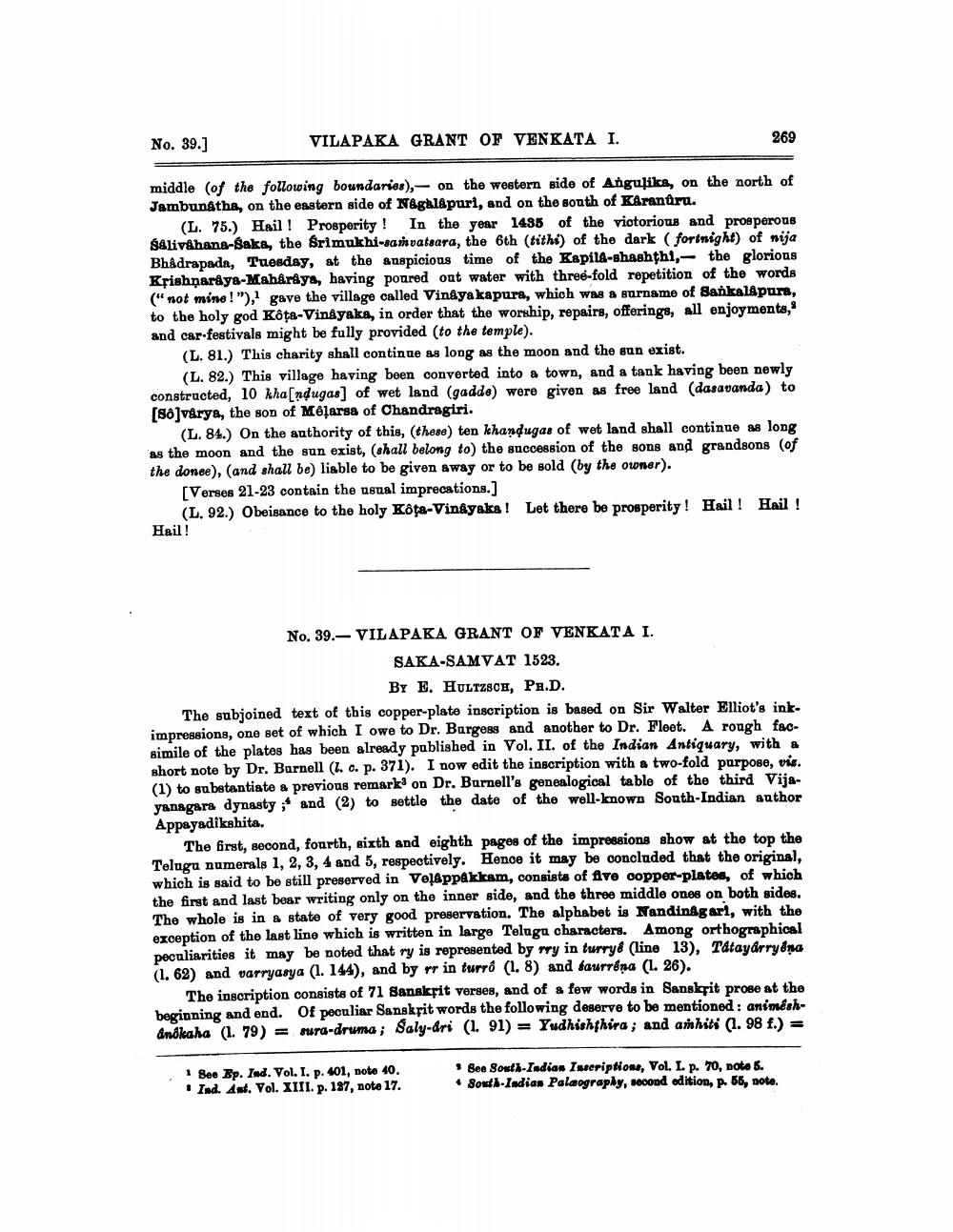________________
No. 39.]
VILAPAKA GRANT OF VENKATA I.
269
middle of the following boundaries),- on the western side of Angulika, on the north of Jambunátha, on the eastern side of Negklepuri, and on the south of Karantiru.
(L. 75.) Hail! Prosperity! In the year 1435 of the victorious and prosperous Alivihana-Saka, the Srimukhi-samvatsara, the 6th (tithe) of the dark (fortnight) of mija Bhadrapada, Tuesday, at the anspicious time of the Kapild-shashthi,- the glorious Krishnaraya-Mahåriya, having poured ont water with three-fold repetition of the words (" not mine!"), gave the village called Vinayakapura, which was a surname of Sankalapura, to the holy god Kôţa-Vinayaka, in order that the worship, repairs, offerings, all enjoyments, and car-festivals might be fully provided to the temple).
(L. 81.) This charity shall continue as long as the moon and the sun exist.
(L. 82.) This village having been converted into a town, and a tank having been newly constructed, 10 kha[ndugas) of wet land (gadde) were given as free land (dasavanda) to [88]vårya, the son of Mélarsa of Chandragiri.
(L. 84.) On the authority of this, (these) ten khandugas of wet land shall continue as long as the moon and the sun exist, (shall belong to the succession of the sons and grandsons (of the donee), (and shall be liable to be given away or to be sold by the owner).
[Verses 21-23 contain the usual imprecations.]
(L. 92.) Obeisance to the holy Kôţa-Vinayaka! Let there be prosperity! Hail! Hail ! Hail !
No. 39.- VILAPAKA GRANT OF VENKATA I.
SAKA-SAMVAT 1523.
By E. HULTZSCH, PA.D. The subjoined text of this copper-plate inscription is based on Sir Walter Elliot's ink. impressions, one set of which I owe to Dr. Burgess and another to Dr. Floet. A rough facsimile of the plates has been already published in Vol. II. of the Indian Antiquary, with a short note by Dr. Barnell (1. c. p. 371). I now edit the inscription with a two-fold purpose, vis. (1) to substantiate a previous remarks on Dr. Burnell's genealogical table of the third Vijayanagara dynasty ;' and (2) to settle the date of the well-known South-Indian author Appayadikshita.
The first second, fourth, sixth and eighth pages of the impressions show at the top the Teluga numerals 1, 2, 3, 4 and 5, respectively. Hence it may be concluded that the original, which is said to be still preserved in Veļ&ppakkam, consists of five copper-plates, of which the first and last bear writing only on the inner side, and the three middle ones on both sides. The whole is in & state of very good preservation. The alphabet is Nandinggari, with the exception of the last line which is written in large Teluga characters. Among orthographical peculiarities it may be noted that ry is represented by try in turryd (line 13), Tatayárrydna (1. 62) and varryasya (1. 144), and by mr in turto (1. 8) and baurrera (1. 26).
The inscription consists of 71 Sanakfit verses, and of a few words in Sanskrit probe at the beginning and end. Of peculiar Sanskrit words the following deserve to be mentioned : animeshandkaha (1.79) = sura-druma; Saly-dri (1. 91) = Yudhishthira; and an hiti (1. 98 f.) =
Seo Bp. Ind. Vol. I. p. 401, noto 40. Ind. Ant. Vol. XIII. p. 187, note 17.
• Bee South Indian Inscriptions, Vol. I. p. 70, DotA 6. • Sond-Indian Palaography, second edition, p. 56, note.




